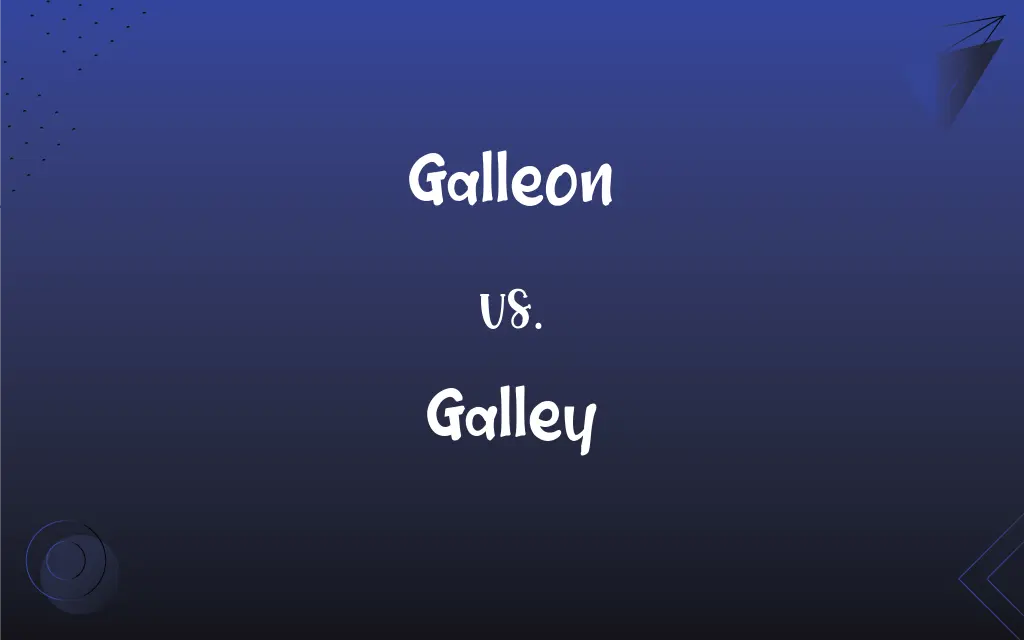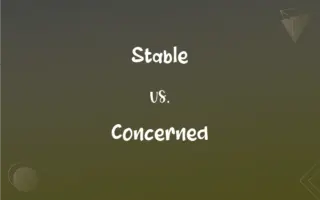Galleon vs. Galley: What's the Difference?
Edited by Janet White || By Harlon Moss || Updated on November 6, 2023
A galleon is a large, multi-decked sailing ship used from the 16th to 18th centuries, while a galley is a long, narrow ship propelled by oars and sails, historically used in the Mediterranean.

Key Differences
Galleons and galleys represent two different classes of sailing vessels with distinct features and historical periods of use. Galleons were large, multi-decked ocean-going ships primarily used by European nations from the 16th to the 18th centuries, known for their role in trade and warfare. Galleys were oar-powered ships with a single deck, used for millennia before galleons, known for their speed and maneuverability in the confined waters of the Mediterranean.
The design of a galleon with its towering superstructure and heavy armament made it less maneuverable than the galley, but more capable of oceanic voyages. Galleys, with their slender profiles and reliance on rowers, were designed for quick engagements and coastal raiding, but they lacked the cargo capacity and seaworthiness for long voyages.
Galleons were a symbol of national might during the Age of Sail, often serving as flagships in naval expeditions. Galleys, on the other hand, were infamous for their use of galley slaves, who propelled these vessels across the seas long before the galleon's era.
The armament of a galleon typically included numerous cannons on multiple decks, making them formidable opponents in naval battles. Galleys were equipped with a ram and sometimes smaller guns, relying on boarding actions and close combat more than artillery.
In terms of legacy, the galleon is often remembered for its role in the colonization of the Americas and the transport of treasures back to Europe. The galley, with its ancient lineage, is often associated with the classical civilizations of Greece and Rome, and later with the maritime republics of the Mediterranean.
ADVERTISEMENT
Comparison Chart
Era
16th to 18th centuries
Ancient times to the Renaissance
Design
Large, multi-decked, heavy armament
Long, narrow, single-decked, oar-powered
Use
Ocean voyages, trade, and warfare
Coastal navigation, quick engagements
Maneuverability
Less maneuverable, built for the open sea
Highly maneuverable, suited for enclosed seas
Crew
Sailors and soldiers
Rowers (often slaves) and marines
ADVERTISEMENT
Galleon and Galley Definitions
Galleon
Designed for long-distance trade and military expeditions.
The galleon set sail for a months-long voyage across the Atlantic.
Galley
Designed for speed and maneuverability in naval battles.
The galley’s design allowed it to outmaneuver larger vessels.
Galleon
A symbol of maritime dominance in the 16th and 17th centuries.
Galleons were the pride of the Spanish Armada.
Galley
An ancient ship propelled mainly by oars.
The Roman galley moved swiftly towards the enemy.
Galleon
A large sailing ship used during the Age of Discovery.
The Spanish galleon was laden with gold from the New World.
Galley
Often used in the Mediterranean for warfare and piracy.
The Ottoman galley was a feared sight along the trade routes.
Galleon
Often heavily armed with cannons to protect against pirates.
The galleon's cannons roared during the ocean battle.
Galley
Typically had a single deck and could carry sails.
The galley carried both oarsmen and sails for versatile movement.
Galleon
Characterized by its square rigging and three or more masts.
The galleon's masts stood tall against the horizon.
Galley
Known for the use of galley slaves for rowing.
The galley slaves rowed tirelessly, chained to their oars.
Galleon
A large three-masted sailing ship with a square rig and usually two or more decks, used in the 1500s, 1600s, and 1700s, especially by Spain as a merchant ship or warship.
Galley
A large, usually single-decked medieval ship of shallow draft, propelled by sails and oars and used as a merchant ship or warship in the Mediterranean.
Galleon
A large, three masted, square rigged sailing ship with at least two decks.
Galley
An ancient Mediterranean seagoing vessel propelled by oars.
Galleon
A sailing vessel of the 15th and following centuries, often having three or four decks, and used for war or commerce. The term is often rather indiscriminately applied to any large sailing vessel.
The galleons . . . were huge, round-stemmed, clumsy vessels, with bulwarks three or four feet thick, and built up at stem and stern, like castles.
Galleon
A large square-rigged sailing ship with three or more masts; used by the Spanish for commerce and war from the 15th to 18th centuries
FAQs
What were galleons used for?
Galleons were used for oceanic voyages, trade, and naval warfare.
What is a galley?
A galley is a long, narrow ship propelled by oars and sometimes sails, used in ancient and medieval times.
How many masts did galleons have?
Galleons typically had three or more masts.
How were galleys propelled?
Galleys were propelled by oars and sometimes by sails.
Did galleys have multiple decks?
No, galleys usually had a single deck.
What kind of weapons did galleons carry?
Galleons were often heavily armed with cannons.
What is a galleon?
A galleon is a large, multi-decked sailing ship from the 16th to 18th centuries.
What were galleys used for?
Galleys were used for quick engagements, coastal navigation, and sometimes as warships.
Could galleons navigate shallow waters?
No, galleons were not built for shallow waters due to their deep drafts.
What kind of weapons did galleys carry?
Galleys carried a ram at the bow and sometimes small guns; they relied on boarding actions.
What time period is the galleon associated with?
The galleon is associated with the Age of Sail, particularly the 16th to 18th centuries.
Are galleys still used today?
No, galleys are also historical and not used today.
Did galleys have sails?
Yes, galleys could have sails, but they were primarily oar-powered.
Did galleons have oars?
No, galleons relied on their sails for movement.
Could galleys navigate shallow waters?
Yes, galleys could navigate shallow waters due to their shallow drafts.
Are galleons still used today?
No, galleons are not used today; they belong to a specific historical period.
Did galleons have rowers?
No, the crew of galleons were sailors and soldiers, not rowers.
What time period is the galley associated with?
The galley is associated with ancient times through the Renaissance.
Were galleons part of the Spanish Armada?
Yes, galleons were prominent ships in the Spanish Armada.
Were galleys used by the Roman Empire?
Yes, galleys were a key part of Roman naval warfare.
About Author
Written by
Harlon MossHarlon is a seasoned quality moderator and accomplished content writer for Difference Wiki. An alumnus of the prestigious University of California, he earned his degree in Computer Science. Leveraging his academic background, Harlon brings a meticulous and informed perspective to his work, ensuring content accuracy and excellence.
Edited by
Janet WhiteJanet White has been an esteemed writer and blogger for Difference Wiki. Holding a Master's degree in Science and Medical Journalism from the prestigious Boston University, she has consistently demonstrated her expertise and passion for her field. When she's not immersed in her work, Janet relishes her time exercising, delving into a good book, and cherishing moments with friends and family.
































































